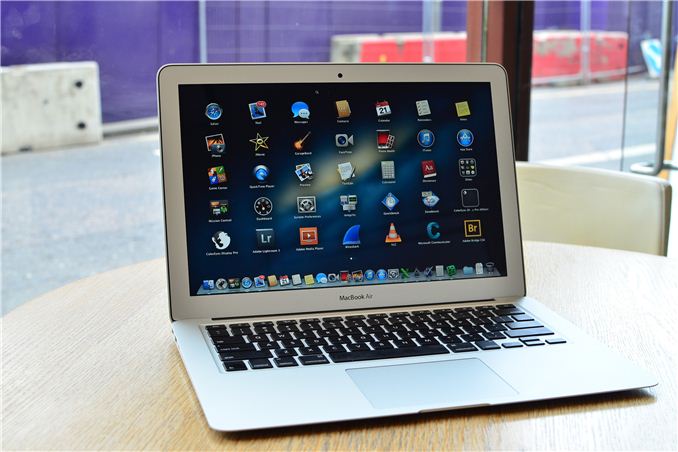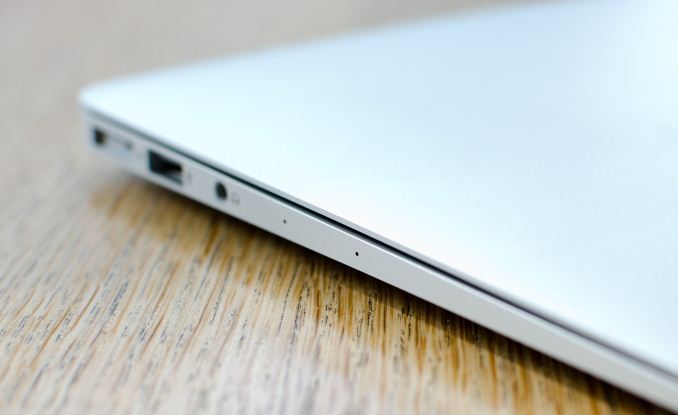The 2013 MacBook Air Review (13-inch)
by Anand Lal Shimpi on June 24, 2013 12:01 AM EST
Things didn’t go exactly as I’d expected at WWDC. I spent the week before the show at Computex, talking to PC OEMs, who had all just launched their Haswell ULT based Ultrabooks. With a couple of exceptions however, the bulk of Haswell ULT systems weren’t scheduled to ship until later this year. Even the Acer S7 I snagged while in Taipei was still a pre-production unit, with final hardware due out in the next month. Based on what I saw in Taiwan, and Intel having seeded me an Iris Pro machine the week before, I assumed that the MacBook Pro with Retina Display is what would get the Haswell treatment first. Obviously, that didn’t happen.
In hindsight, the move makes sense. Apple will sell far more MacBook Airs than rMBPs. The Apple/Intel relationship is looking very healthy these days, so it’s also not surprising that it would have supply and early enough access to Haswell ULT to launch the MBAs at WWDC with almost immediate availability. The Haswell ULT shift didn’t require a new chassis for Apple, which meant a less complex development process.
From the outside, the new MacBook Air looks nearly identical to its predecessor. There's a second mic opening on the left side of the machine now, but otherwise you'd be hard pressed to tell this year's model apart from the previous generation. Internally, nearly everything has changed.
The battery is higher capacity, with no increase in weight. Making better use of that larger battery is Intel's new Haswell ULT silicon. Since we're talking about a ULT part, the PCH moves from the motherboard to the CPU package - creating an emptier motherboard than we've seen in previous years:
The 2013 13-inch MacBook Air Motherboard, Courtesy iFixit
It's clear to me that the MBA is due for a more significant redesign, but this is not the year for that.
Alongside Haswell comes a brand new PCIe SSD, 802.11ac support and LPDDR3 memory. All at a price equal to, if not less than last year's models:
| 2013 MacBook Air Lineup | ||||||
| 11.6-inch | 11.6-inch (high-end) | 13.3-inch | 13.3-inch (high-end) | |||
| Dimensions |
H: 0.11-0.68" (0.3-1.7cm)
W: 11.8" (30cm) D: 7.56" (19.2cm) |
H: 0.11-0.68" (0.3-1.7cm)
W: 12.8" (32.5cm) D: 8.94" (22.7cm) |
||||
| Weight | 2.38 lbs (1.08kg) | 2.96 lbs (1.35kg) | ||||
| CPU | 1.3GHz dual-core Core i5 | 1.3GHz dual-core Core i5 | ||||
| GPU | Intel HD 5000 | |||||
| RAM | 4GB LPDDR3-1600 | |||||
| SSD | 128GB PCIe SSD | 256GB PCIe SSD | 128GB PCIe SSD | 256GB PCIe SSD | ||
| Display Resolution | 1366 x 768 | 1440 x 900 | ||||
| Ports | Thunderbolt, 2x USB 3.0, headphone jack | Thunderbolt, 2x USB 3.0, SD card slot, headphone jack | ||||
| Networking | 2x2:2 802.11ac | 2x2:2 802.11ac | ||||
| Battery | 38 Wh | 54 Wh | ||||
| Price | $999 | $1199 | $1099 | $1299 | ||
We've been over the MacBook Air chassis thoroughly in the past so I won't go through it again here. Build quality remains excellent. The clickpad and backlit keyboard never give me any troubles either. It's sad that we're still having clickpad issues elsewhere in ultraportables but this is one area where Apple's vertically integrated advantage is apparent (as is the company's willingness to spend a little extra on even the little details).
The only thing that hasn't changed, that perhaps should have is the display. The MacBook Air retains the same 1366 x 768/1440 x 900 panels from last year, while much of the competition has moved to at least 1080p IPS in the 13.3-inch form factor. This year at Computex we saw a number of systems move to 2560 x 1440 13.3-inch panels, at least as an option, however I'm expecting those systems to be priced more in line with the 13-inch rMBP rather than the MacBook Air. Admittedly, I don't know the right solution here.Ultra high resolution panels drive cost and power consumption up, the latter which can be offset by going to a larger battery - but then you have a 13-inch rMBP. Perhaps the right move for the MacBook Air would be for Apple to move to IPS panels at least? Or maybe we see a merger of the 13-inch MBA/rMBP, and something new entirely replace the 11-inch model.












233 Comments
View All Comments
p1esk - Monday, June 24, 2013 - link
At longer length or if there are electrical interferences, Cat6 will be better for 1Gbps than Cat5e.spronkey - Monday, June 24, 2013 - link
Technically Cat5e doesn't have to reach 1Gbps at 100m lengths, which is the 1Gbps standard. So, Cat6 is the 1Gbps standard :PA5 - Monday, June 24, 2013 - link
Though you'd have to buy some seriously cheap Cat5e to get something that doesn't hit that spec. But yeah, if you're going in-wall you may as well go Cat6 for when you want a 10G network.Mikad - Monday, June 24, 2013 - link
Thanks for the review.If it's at some point updated with i7 battery life results, it would be great if you could run the battery tests in Windows + Bootcamp also. Some sites have done this, like Pcper, and there has been about 50% decrease in battery life. It would be great to have some kind of an analysis why the battery life takes such a hit in Windows.
IntelUser2000 - Monday, June 24, 2013 - link
Because the battery life gains due to Haswell are based on how well the components are cooperating together, and sub-optimal drivers would easily cancel the improvements out.That's why you see Haswell Windows Ultrabooks do pretty good, but Macbook Air running Windows isn't doing so well.
Glindon - Monday, June 24, 2013 - link
I don't think it really has much to do with drivers. There's nothing special about the components compared to a Windows ultra book. I think it boils down to something at the EFI level and Apple isn't going to prioritize it for a small subset of users. I'm guessing that running Windows in a VM (through Parallels) might give better battery life.darwinosx - Monday, June 24, 2013 - link
Yes there is. Which you would know if you read the articleApple uses custom sad, motherboard, chipsets and a few other compoenents. Thats why the sad is so much faster for example.
erple2 - Monday, June 24, 2013 - link
That, BTW, was one of the greatest autocorrects I've seen in a while. Full of fast sad indeed.Bkord123 - Tuesday, June 25, 2013 - link
hahaha!!!Mikad - Monday, June 24, 2013 - link
I've seen the drivers mentioned as the reason before, but as Glindon stated, the components are just the standard PC stuff, found in other ultrabooks. The drivers are probably the same too.